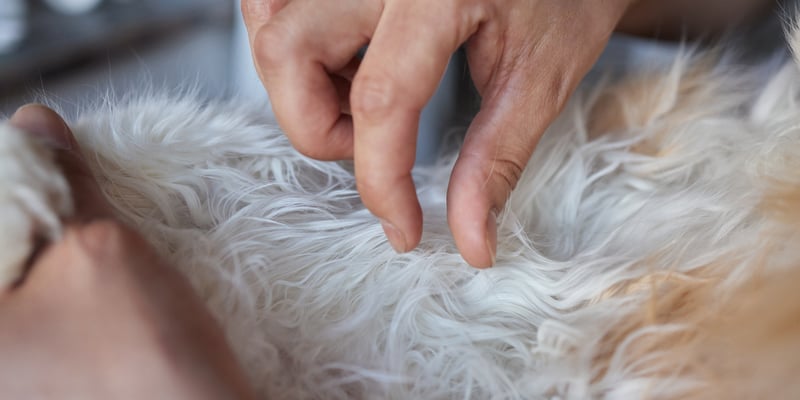Cat Skin Tags 101: Symptoms, Removal and Expert Advice
Index:



Introduction
Welcome to our comprehensive guide on cat skin tags. If you're a concerned pet owner this article aims to provide you with all the information you need to understand and effectively deal with cat skin tags.
We will discuss the symptoms of skin tags in cats, the removal process and offer expert advice for managing and preventing these common feline skin growths.
Key takeaways:
Cat skin tags are small bumps or benign overgrowths that can be distinguished from malignant tumours.
Blood vessels play a role in the development of skin tags in cats.
Common triggers for skin tag formation in cats include friction, obesity and hormonal changes.
Regular skin checks are essential for early detection of skin tags and other abnormalities.
Consulting a veterinarian is crucial for accurate diagnosis and personalised treatment plans for cat skin tags.



Understanding cat skin tags and their causes
In this section, we will delve into the details of cat skin tags. We will explain how to distinguish between benign overgrowths and malignant tumours. We will also explore the role of blood vessels in the development of skin tags in cats.
Additionally, we will discuss the theory of common triggers such as environmental irritants that can lead to the formation of skin tags in felines.
To further understand how to maintain your cat's skin health and prevent issues like skin tags, reading about how to banish cat dandruff can provide valuable insights into proper grooming and care.
Identifying benign overgrowths versus malignant tumours
When it comes to feline skin tags, it's essential to differentiate between benign overgrowths and malignant tumours. Skin disorders such as tags and cysts are non-cancerous growths that typically don't pose a significant threat to your cat's health.
On the other hand, malignant skin tumours are cancerous and can spread to other parts of the body. In some cases, a skin tag may appear harmless but could actually be a tumour, which requires immediate medical attention.
It's crucial to consult a veterinarian for a proper diagnosis to ensure the appropriate course of action.
Recognising symptoms that may seem minor but could indicate more serious health issues is crucial, much like understanding the causes and treatments for other health questions such as 'what is a cat weepy eye?', emphasising the need for a professional diagnosis.
The role of blood vessels in skin tag development
Blood vessels play a vital role in the development of skin tags in cats. These tiny growths are made up of collagen fibres and blood vessels. The blood vessels supply the necessary nutrients and oxygen to the skin tag, helping it grow. Understanding the role of blood vessels in skin tag development can provide insights into the underlying mechanisms and potential treatment options.
Common triggers for skin tag formation in cats
It is thought that there are several common triggers that can lead to the formation of skin tags in cats. While the exact cause is often unknown, certain factors increase the likelihood of their development.
These triggers can include:
Friction or rubbing against skin
Obesity or excessive weight gain
Poor grooming habits or hygiene
Genetics or predisposition
Hormonal imbalances
Environmental irritants
Understanding these common triggers can help pet owners take preventive measures and minimise the risk of skin tag formation in their feline companions.
Monitoring your feline's skin: when to be concerned
In order to ensure the health and well-being of your beloved cat, it is crucial to monitor their skin regularly and be aware of any potential skin tag-related issues.
By staying vigilant and attentive, you can catch any abnormalities early on and take appropriate action. As pet parents, we never want to find a strange bump on our cat's skin.
Just as it's important to monitor skin tags, being aware of other skin conditions is vital. Learn about one such condition by exploring miliary dermatitis in cats and its impact on your pet's health.
Differentiating between harmless growths and warning signs
When examining your cat's skin, it's important to be able to distinguish between harmless growths and any warning signs of serious underlying issues. Skin tags are generally harmless and pose no significant threat to your cat's health. They often appear as small, flesh-coloured or slightly darker growths that hang off the skin.
On the other hand, warning signs may include rapidly growing skin tags, changes in shape or colour, or the presence of multiple skin tags in a concentrated area. If you notice any of these characteristics, it is advisable to consult a veterinarian for further assessment and guidance.
The importance of regular skin checks for early detection
Regular skin checks are a vital component of feline healthcare. By routinely examining your cat's skin, you can detect skin tags and other abnormalities early on, which can lead to prompt diagnosis and intervention.
Schedule regular check-ups with your veterinarian and learn how to perform skin checks at home between visits.
Cat skin tag diagnosis: expert techniques and procedures
In order to accurately diagnose cat skin tags, veterinary experts utilise a variety of techniques and procedures. These methods are designed to provide a comprehensive understanding of the skin tags and ensure effective treatment. Let's explore the specific techniques and procedures used in the diagnosis process.
Physical examination: The initial step in diagnosing cat skin tags involves a thorough physical examination of the affected areas. Veterinary professionals carefully inspect the skin tags, noting their size, shape, colour, and location.
Biopsy: In some cases, a biopsy may be necessary to confirm the diagnosis. A small sample of the skin tag tissue is extracted and sent to a laboratory for analysis. This allows experts to determine whether the growth is benign or malignant, providing crucial information for treatment planning.
Digital imaging: Advanced techniques, such as digital imaging, may be employed to capture detailed images of the skin tags. These images can be analysed and compared over time to track any changes in the size or appearance of the growths.
Diagnostic equipment: Veterinary professionals often utilise specialised diagnostic equipment to aid in the diagnosis of cat skin tags. This may include dermatoscopes, which provide a magnified view of the skin, or ultrasound devices, which can help determine the depth and extent of the skin tag.
By employing these expert techniques and procedures, veterinary professionals can effectively diagnose cat skin tags and provide appropriate treatment plans for the well-being of feline companions.
Similar to how we use expert techniques for diagnosing skin tags, diagnosing other conditions such as cat eye problems also requires specialised knowledge and equipment, highlighting the importance of professional veterinary care.
Treatment options for cat skin tags
When it comes to treating cat skin tags, there are several options available to consider. The choice of treatment will depend on various factors, including the severity of the skin tags, the overall health of the cat and your preferences as the pet owner.
Choosing the right treatment method for your pet, whether it's for skin tags or other conditions like cat ear infections, should always be done with guidance from a veterinarian to ensure the health and well-being of your feline friend.
Navigating surgical removal and non-invasive alternatives
One of the main treatment options for cat skin tags is surgical removal. This procedure involves the physical excision of the skin tag by a veterinarian.
While surgical removal is effective in eliminating the skin tag, it may require anaesthesia and sutures, and there may be a risk of infection or scarring.
Alternatively, there are non-invasive alternatives that can be considered. Non-invasive treatments for cat skin tags may include cryotherapy, where the skin tag is frozen, or electrocautery, where the skin tag is burned off using an electric current.
These methods are generally less invasive and may require less recovery time compared to surgical removal.
Another common method for removing a cat skin tag is ligation, which involves wrapping a string around the base of the tag to cut off its oxygen and blood supply.
This causes the skin tag to eventually wither and fall off. Another option is surgical removal, where the tag is excised or cut off by a veterinarian. This method may require sedation or general anaesthesia, especially for larger tags or those located in sensitive areas.
It's essential to consult with a veterinarian before attempting any treatment for your cat's skin tag. They can provide guidance on the best course of action based on the tag's size, location and your cat's overall health.
Additionally, attempting to remove a skin tag at home can lead to complications such as infection or excessive bleeding, so it's crucial to seek professional advice.
In some cases, skin tags may be removed during other procedures, such as a dental cleaning or spaying/neutering surgery.
This approach minimises the need for additional anaesthesia and ensures the tag is safely removed under veterinary supervision.
Ultimately, the goal of treatment for cat skin tags is to ensure your pet's comfort and well-being. By working closely with your veterinarian, you can develop a treatment plan that addresses your cat's needs and ensures the best possible outcome.
Considering topical creams and home care strategies
Another option for managing cat skin tags is the use of topical creams. There are various creams and ointments available that claim to shrink or dissolve skin tags.
These products typically contain ingredients such as salicylic acid or tea tree oil, which are believed to have skin tag-reducing properties.
However, it is important to note that the effectiveness of topical treatment may vary, and consulting with a veterinarian is recommended before using any such product on your cat.
In addition to topical creams, implementing home care strategies can also be beneficial in managing cat skin tags.
This may include keeping the affected area clean and dry, avoiding any irritants and ensuring that the cat's overall health and immune system are supported through a balanced diet and regular exercise.
Creating a personalised treatment plan with your vet
It is essential to work closely with a veterinarian to create a personalised treatment plan for your cat's skin tags.
The veterinarian will assess the cat's individual condition and provide expert advice on the most suitable treatment options.
They will take into consideration factors such as the cat's age, overall health and any underlying medical conditions to create a tailored approach for managing and treating the skin tags effectively.
By collaborating with a veterinarian and exploring the various treatment options available, you can ensure that your cat receives the most appropriate and personalised care for their skin tags.



Conclusion
In conclusion, understanding cat skin tags is crucial for the well-being of our feline companions. By recognising the symptoms and seeking expert advice, we can ensure proper diagnosis and treatment.
Whether it's distinguishing between harmless growths and warning signs or monitoring our cats' skin with regular checks, staying vigilant is essential.
Throughout this article, we have highlighted the importance of accurate diagnosis, exploring the techniques and procedures used by veterinary experts.
From surgical removal to non-invasive alternatives, there are various treatment options available. It's also worth considering the use of topical creams and home care strategies in consultation with a veterinarian.
To manage and prevent cat skin tags effectively, it is essential to create a personalised treatment plan.
By working closely with our vets, we can optimise the well-being and health of our furry friends. Remember, early detection and intervention play a key role in maintaining their vitality and happiness.
FAQs
What are the symptoms of cat skin tags?
Cat skin tags typically appear as small, fleshy growths attached to the skin. They are usually harmless and do not cause any pain or discomfort to the cat. However, if the skin tag becomes irritated or starts to bleed, it is important to seek veterinary attention.
How are cat skin tags removed?
The removal of cat skin tags can be done through surgical procedures or non-invasive alternatives, such as ligation, cryotherapy or electrocautery. The choice of removal method depends on the size, location, and number of skin tags, as well as the overall health of the cat.
What is the expert advice for managing and preventing cat skin tags?
To manage and prevent cat skin tags, it is important to regularly monitor your cat's skin and promptly seek veterinary attention if you notice any abnormal growths or changes. Maintaining a healthy diet and regular grooming routine can also contribute to overall skin health.
How can I differentiate between benign skin tags and malignant tumours in cats?
Benign skin tags in cats are usually soft, fleshy growths that do not change in size or shape over time. Malignant tumours, on the other hand, may exhibit rapid growth, irregular borders, and may be accompanied by other symptoms like ulceration or hair loss. If you suspect a malignant tumour, it is crucial to consult a veterinarian for an accurate diagnosis.
What are the common triggers for the formation of skin tags in cats?
Skin tags in cats can be triggered by a variety of factors, including genetic predisposition, skin friction or irritation, flea allergy, hormonal imbalances and sun damage. It is important to identify and address these triggers to prevent the development of skin tags in cats.
How often should I check my cat's skin for skin tags and abnormalities?
It is recommended to regularly inspect your cat's skin for any new growths, lumps, or changes in colour or texture. Performing a thorough skin check at least once a month can help catch skin tags and other abnormalities early, allowing for prompt veterinary intervention if necessary.
What are the diagnostic techniques and procedures used for cat skin tags?
The diagnosis of cat skin tags usually involves a physical examination of the growths by a veterinarian. In some cases, a needle aspiration may be performed to obtain a sample of cells for further analysis. Diagnostic imaging, such as ultrasound or biopsy, may also be utilised for a more accurate diagnosis.
Waggel Pet Insurance
Need more help? You're in luck if you're a Waggel Pet Insurance member. Along with our excellent coverage, we offer access to a 24/7 online vet to answer all your sticky questions, especially if you need grooming assistance.
Not a member? Why not get a quote now and cover your furry friend for a range of illnesses, all while enjoying our amazing perks and rewards.
Want more like this?
Get updates from us with helpful info, advice, answers to frequently asked questions and much more.
Index:
Related posts:
Get your quote
Along with our excellent coverage, we offer access to a 24/7 online vet to answer all your sticky questions.





